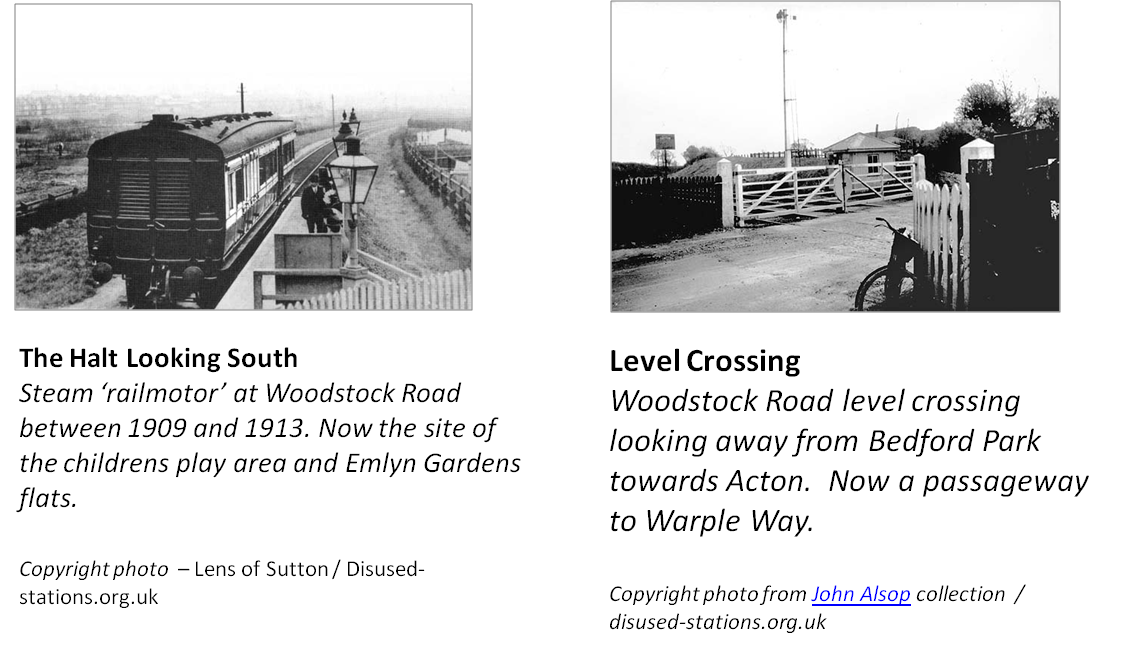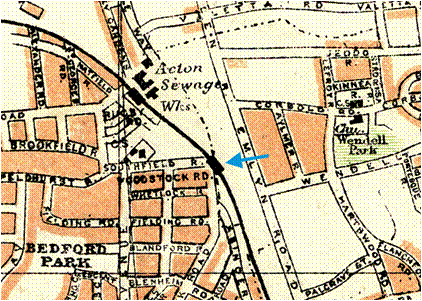Building The Lines Across Stamford Brook
Stamford Brook today is dominated by a single District Line viaduct that cuts across the area from East to West. This was originally built by the 'London and South Western Railway' (L&SWR) and by the 1850s, it had already connected Ealing and Richmond to the City with lines that crossed Acton Green. From the 1850s to the First World War, Stamford Brook was the centre of a railway boom with various companies competing to offer the quickest route into the City to local residents. The L&SWR had initially been built without a stop at Stamford Brook and for a while three different railway companies shared the lines to Richmond in addition to the L&SWR (see Wikipedia for details). By the time Stamford Brook station was opened in 1912 only the L&SWR and the District Railway were still using it. Eventually the L&SWR ceased operations leaving it to the District Railway (which later became the District Line of the London Underground).
One of the One of the eventual losers in this battle was our own ‘lost’ railway through Stamford Brook - the Hammersmith branch of a railway called the North and Southwestern Junction Railway (NSWJR) which ran from Kew, via South Acton to the City. This branch line existed until the 1960s and ran behind the gardens of the houses on the west side of Emlyn Road, on the land now converted to allotments and the Emlyn Gardens estate. See the wonderful video from 'The Londonist' below:
Video by the Londonist
Started in 1857, the line was designed to pick up passengers at a now dissappeared 'Hammersmith & Chiswick Station' at the Stamford Brook end of Chiswick High Road (where the modern flats now stand next to Chiswick Auctions). The line then curved left behind what are now Hatfield and Greenend Roads. The original line of the railway marked on the line on which these houses were later built. The pumping station at Warple Way now sits on the railway site. It curved further round to link up to the main part of the line, the NSWJ’s Kew to Fenchurch Street line (now the London Overground line to Richmond) at the Acton Gatehouse Junction. This rather awkwardly left the carriages facing the wrong way for journeys onto the City and the passengers had to change.The line ran north from there and crossed Bath Road where there was a level crossing with a footbridge (next to where the Seventh Day Adventist Church now stands). This footbridge was painted by Camille Pissarro during his stay in the area and was there until about 1930. The level crossing gates were in use, stopping traffic in the Bath Road, until 1965. The line continued north on the land now covered by allotments behind Abinger Road and Emlyn Road.


After Stamford Brook Station was opened in 1912 on what became the District Line, passengers drifted away from the Acton to Hammersmigh branch line, as the District offered a simpler journey into the City. In response, the NSWJ opened three extra 'halts' to try and pick up more passengers on the line. These were at Bath Road, Woodstock Road and Rugby Road.
However the branch line was never able to compete against the quicker and more convenient route into London, which brought a drop in passengers to a line that was already running at a loss. The passenger service was withdrawn in 1917. During World War II, the line carried a mobile anti-aircraft gun, up and down behind the houses on Abinger, and the daily freight train continued to operate into the 1960s. All services were withdrawn on 3 May 1965 and the track was lifted shortly afterwards. The only memory of it is in Camille Pissaro's paintings and some rare photos shown here.


The LSWR's new route opened on 1 January 1869; it was from north Kensington, turning south through its own 'Shepherds Bush' and 'Hammersmith' (Grove Road) stations - neither this line or the two station still exist. After Hammersmith it then turned west along the alignment that is now the District line on the brick viaduct that cuts across Stamford Brook, then turning south-west through Brentford Road station (now called Gunnersbury), crossing the Thames to Richmond.
This new line crossed over the existing LNWR lines at Stamford Brook on its way to Turnham Green. At this point, there was no station at Stamford Brook (see note on station below).
Some websites for further reading on the London & Southwest Railway:
https://en.wikipedia.org/wiki/LSWR_suburban_lines
https://railwaywondersoftheworld.com/lswr.html
http://www.disused-stations.org.uk/b/bath_road_halt/index1.shtml

